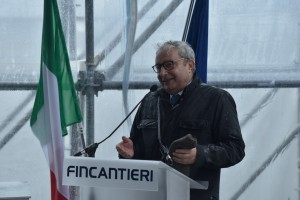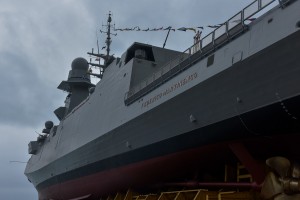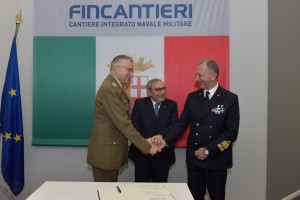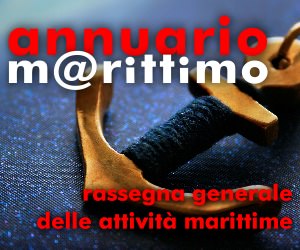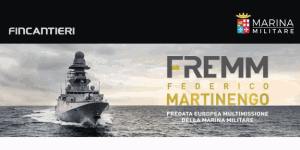
Trieste, 4 marzo 2017 – Si è svolta oggi presso lo stabilimento di Riva Trigoso (Genova) la cerimonia di varo della fregata “Federico Martinengo”, settima di una serie di 10 unità FREMM – Fregate Europee Multi Missione, commissionate a Fincantieri dalla Marina Militare Italiana nell’ambito dell’accordo di cooperazione internazionale italo-francese, con il coordinamento di OCCAR, l’organizzazione congiunta per la cooperazione europea in materia di armamenti.
Madrina del varo è stata la signora Mina De Caro, vedova di Giuseppe Porcelli, Comandante della Fregata “Scirocco”, che perse la vita nel 1997 durante un’attività operativa condotta nell’ambito della Forza Navale NATO nel Mediterraneo.
Alla cerimonia sono intervenuti, fra gli altri, Gen.Claudio Graziano, Capo di Stato Maggiore della Difesa, Amm. di squadraValter Girardelli, Capo di Stato Maggiore della Marina Militare, Giovanni Toti, Presidente della Regione Liguria e Giuseppe Bono, Amministratore Delegato di Fincantieri.
A seguito del varo, l’unità proseguirà le attività di allestimento presso il Cantiere Integrato Navale Militare nel sito di Muggiano, a La Spezia, e sarà consegnata nei primi mesi del 2018. Nave “Federico Martinengo” sarà caratterizzata, come le altre, da un’elevata flessibilità d’impiego e avrà la capacità di operare in tutte le situazioni tattiche. Ha una lunghezza di 144 metri, una larghezza di 19,7 metri e un dislocamento a pieno carico di circa 6.700 tonnellate. Può raggiungere una velocità superiore ai 27 nodi con una capacità massima di personale trasportato pari a 200 persone.
Il programma FREMM, che rappresenta lo stato dell’arte della difesa italiana ed europea, nasce dall’esigenza di rinnovamento della linea delle unità della Marina Militare della classe Lupo (già radiate) e Maestrale (prossime al raggiungimento del limite di vita operativo), costruite da Fincantieri negli anni Settanta.
Nel corso del 2013 sono state consegnate “Carlo Bergamini” e “Virginio Fasan”, nel 2014 “Carlo Margottini”, nel 2015 “Carabiniere”, mentre nel 2016 è stata la volta di “Alpino”. Con l’esercizio dell’opzione, nell’aprile 2015, per la costruzione della nona e della decima unità, la cui consegna è prevista dopo il 2020, si è data completa attuazione al programma italiano.
L’iniziativa vede la partecipazione in qualità di prime contractor per l’Italia di Orizzonte Sistemi Navali (51% Fincantieri, 49% Finmeccanica) e per la Francia di Armaris (DCNS + Thales).
Questa cooperazione ha capitalizzato l’esperienza positiva del precedente programma italo-francese “Orizzonte” che ha portato alla realizzazione di due cacciatorpediniere per la Marina italiana, l’“Andrea Doria” e il “Caio Duilio”.
* * *
NOTE BIOGRAFICHE FEDERICO MARTINENGO
Contrammiraglio
Medaglia d’oro al Valor Militare alla memoria
Ufficiale Ammiraglio dotato di spiccatissime doti di mente, di cuore e di carattere come già durante la guerra 1915-18, anche nella guerra 1940-43 negli importanti incarichi che svolse a bordo ed a terra, diede prova di profonda preparazione, di sicura fede e coraggio. All’atto dell’armistizio, incaricato del trasferimento delle unità antisommergibili presenti a La Spezia e della inutilizzazione di quelle non in grado di muovere, svolse il suo mandato con decisa risolutezza, pur attraverso enormi difficoltà create dalla situazione contingente. Con una sezione di V.A.S. lasciò il porto solo nell’imminenza dell’occupazione della piazza da parte di forti reparti tedeschi. Incontrata in mare una sezione di motosiluranti germaniche, decise immediatamente, nonostante la condizione di marcata inferiorità, di accettare l’impari lotta. Serrate le distanze l’affrontò con azione ravvicinata e non lasciò tregua fin quando, colpito mortalmente, cadde esanime mentre il Suo spirito continuava ad aleggiare sugli equipaggi che da terra proseguivano la lotta, desistendo solo quando le unità germaniche duramente provate nei mezzi e negli uomini si ritiravano dall’azione.
Alto Tirreno, 9 settembre 1943
Nacque a Roma il 18 luglio 1899. Dopo aver terminato i Corsi all’Accademia Navale di Livorno il 25 maggio 1915 e conseguita la nomina a Guardiamarina, partecipò al primo conflitto mondiale imbarcato prima sulla nave da battaglia Conte di Cavour e poi sulla nave da trasporto Trinacria (ex mercantile inglese America). Nel settembre 1916 passò ad operare presso la Stazione Idrovolanti di Venezia e, conseguito il brevetto da pilota e di osservatore, partecipò a numerose missioni di guerra.
Operò poi a Sebenico, presso quella Stazione Idrovolanti, e nel 1919 si imbarcò su torpediniera nell’incarico di ufficiale in 2a. Promosso Capitano di Corvetta nel 1927 e Capitano di Fregata nel 1932; dal 1931 al 1933 ebbe il comando del Distaccamento Marina a Tientsin (Cina). Rimpatriato, frequentò l’Istituto di Guerra Marittima a Livorno e, promosso Capitano di Vascello, ebbe prima il comando della Base Navale di Lero e poi quello dell’incrociatore Muzio Attendolo, con il quale entrò in guerra il 10 giugno 1940, partecipando alla battaglia navale di Punta Stilo e a numerose altre missioni di guerra.
Nell’ottobre 1940 assunse la carica di Capo di Stato Maggiore del Dipartimento M.M. di Taranto, che mantenne fino alla promozione a Contrammiraglio; il 10 aprile 1943 assunse il Comando Superiore dei Mezzi Antisommergibili a La Spezia, dove si trovava l’8 settembre 1943, all’atto dell’armistizio. In ottemperanza agli ordini ricevuti partì da La Spezia il mattino del giorno 9, imbarcato sulla VAS 234, con la sezionaria VAS 235. Poco prima delle 14.00 le due vedette furono attaccate da motosiluranti tedesche. Il combattimento durò circa un’ora, con danni da tutte a due le parti, finche le VAS, esaurite le munizioni, si ridossarono a Cala Scirocco (Gorgona) dove la VAS 234, nuovamente e duramente impegnata, venne affondata, portandosi sul fondo anche l’eroico Ammiraglio, già mortalmente colpito da raffica di mitraglia nemica mentre si trovava al timone dell’unità che portava la sua insegna.
Altre decorazioni:
- Medaglia d’Argento al Valore Militare (Alto Adriatico, ottobre 1916);
- Medaglia d’Argento al Valore Militare (Alto Adriatico;. maggio – luglio 1917);
- Croce di Guerra al Valore Militare (gennaio 1918).
——————————————————————-
THE SEVENTH MULTIPURPOSE FRIGATE “FEDERICO MARTINENGO” LAUNCHED
The Italo-French FREMM program continues
Trieste, March 4, 2017 – The launching ceremony of the “Federico Martinengo” frigate, the seventh of a series of 10 FREMM vessels – Multi Mission European Frigates – took place today at the Riva Trigoso shipyard (Genoa). The 10 FREMM vessels have been commissioned to Fincantieri by the Italian Navy within the framework of an Italo-French cooperation program under the coordination of OCCAR (Organisation Conjointe de Cooperation sur l’Armement, the international organization for cooperation on arms).
Godmother of the ceremony was Mrs. Mina De Caro, widow of Giuseppe Porcelli, Commander of the “Scirocco” frigate, who lost his life in 1997 during operational activities held within NATO naval forces in the Mediterranean.
The ceremony was attended, among others by Gen.Claudio Graziano,Chief of Defence, Adm. Valter Girardelli, Chief of Staff of the Italian Navy, Giovanni Toti, Governor of the Liguria Region,and Giuseppe Bono,CEO of Fincantieri.
After the launching, fitting activities will continue in the Integrated naval shipyard of Muggiano (La Spezia), with delivery scheduled in early 2018. The “Federico Martinengo” vessel, like the other units, will feature a high degree of flexibility, capable of operating in all tactical situations. 144 metres long with a beam of 19.7 metres, the ship will have a displacement at full load of approximately 6,700 tonnes. The “Federico Martinengo” will have a maximum speed of over 27 knots and will provide accommodation for a 200-person crew.
The FREMM program, representing the European and Italian defence state of the art, stems from the renewal need of the Italian Navy line “Lupo” (already removed) and “Maestrale” (close to the attainment of operational limit) class frigates, both built by Fincantieri in the 1970s.
The vessels “Carlo Bergamini” and “Virginio Fasan” have been delivered in 2013, the “Carlo Margottini” in 2014, the “Carabiniere” in 2015 and the “Alpino” in 2016. The Italian program has been fully implemented with the option exercised in April 2015, regarding the construction of the ninth and tenth vessel, whose delivery is scheduled after 2020.
Orizzonte Sistemi Navali (51% Fincantieri, 49% Finmeccanica) acts as prime contractor for Italy in the initiative, while Armaris (DCNS + Thales) is prime contractor for France.
This cooperation has applied the positive experience gained in the previous Italo-French program “Orizzonte” that has led to the construction for the Italian Navy of the two frigates ”Andrea Doria” and “Caio Duilio”.
* * *
BIOGRAPHICAL NOTES FEDERICO MARTINENGO
Rear Admiral
Golden Medal for Military Value awarded posthumously
Commander Admiral, during WW1 and WW2 he demonstrated strong qualities of mind, heart and character in the important positions which he carried out on board and on-shore. He displayed deep preparation, secure faith and courage.
At the signing of the armistice, he was in charge of transferring the anti-submarine units in La Spezia and of the non-use of those units which were not able to move, carrying out his task vigorously, even in great difficulties given by the in-hand situation. He left the port all alone with a V.A.S. section during the imminent occupation of the square by the strong German units. At sea he met a section of German torpedo boats, immediately deciding, despite the evident inferiority condition, to accept the unequal struggle. He handled the fight with close action, giving no respite until, fatally hit, he fell lifeless while his spirit continued to move over the crews. They continued the fight at ground, desisting only when the German units, hardly hit, withdrew from the action.
Northern TyrrhenianSea, 9 September, 1943
He was born in Rome on July, 18 1899. After completing courses at the Naval Academy in Livorno on May 25, 1915 and being appointed as midshipman, he participated in the First World War embarked on the first battleship Conte di Cavour and then on the transport vessel Trinacria (once America, British merchant ship). In September 1916 he passed on to the seaplanes station in Venice, where he achieved the pilots and observer license, participating in several war patrols.
He then operated in Sibenik at the seaplanes station, and in 1919 he embarked on the torpedo boat in his role as second officer. He was promoted to Corvette Captain in 1927 and to Frigate Captain in 1932; from 1931 to 1933 he was in command of the Marine Detachment in Tianjin (China). Repatriated, he attended the Naval War Institute in Livorno and was promoted to Captain. He first had the command of the naval base of Leros and then the one of the cruiser Muzio Attendolo, with which he entered the war on June 10, 1940, participating in the naval Battle of Punta Stilo as well as in many other war patrols.
In October 1940, he was appointed Chief of Staff of the Department M.M. of Taranto, which he held until his promotion to Rear Admiral; on April 10, 1943 he took over the High Command of anti-submarine vessels in La Spezia, where he was on September 8, 1943, day when the armistice was signed. In compliance with the orders he received, he left La Spezia on the morning of the 9th, embarked on VAS 234 with the VAS 235. Shortly before 2 pm the two lookouts were attacked by German torpedo boats. The fighting lasted about an hour, with damage on both sides, until the VAS, ran out of ammunitions, sheltered in Cala Scirocco (Gorgona) where the VAS 234, was sunk taking with her the heroic admiral, already fatally machine-gunned by the enemy while he was steering the unit which carried his sign.
Other decorations:
- Silver Medals to the Military Value (Upper Adriatic, October 1916);
- Silver Medals to the Military Value (Upper Adriatic, May – July 1917);
- Military Cross to the Military Value (January 1918).











